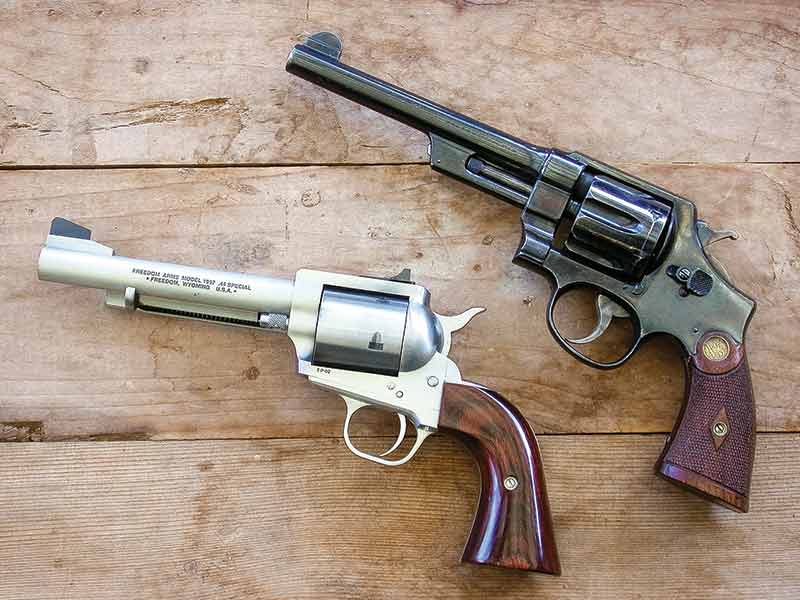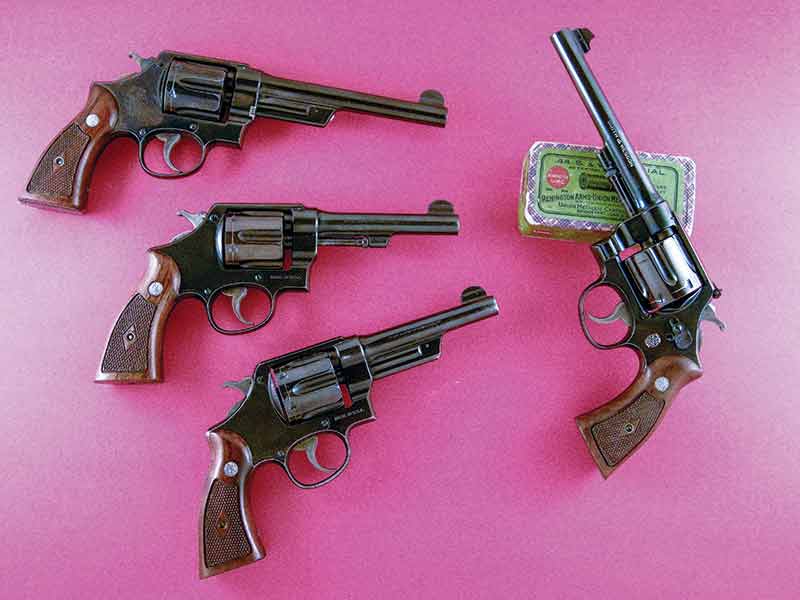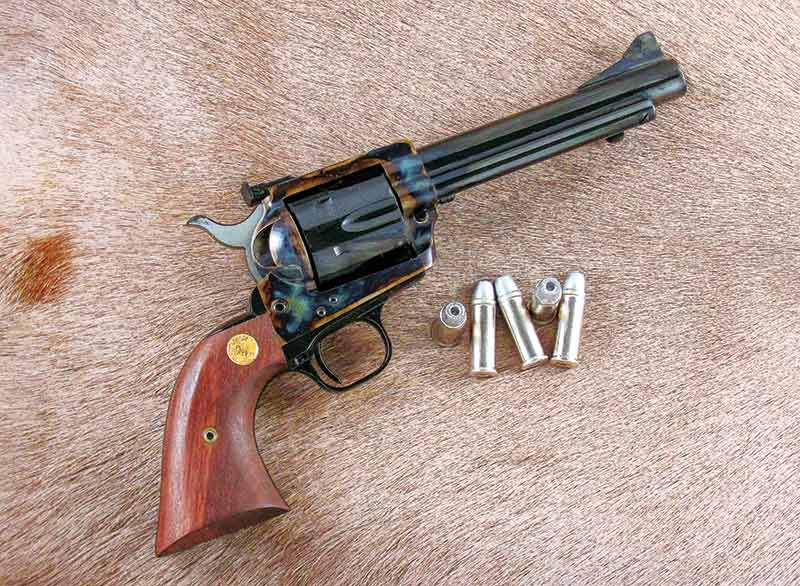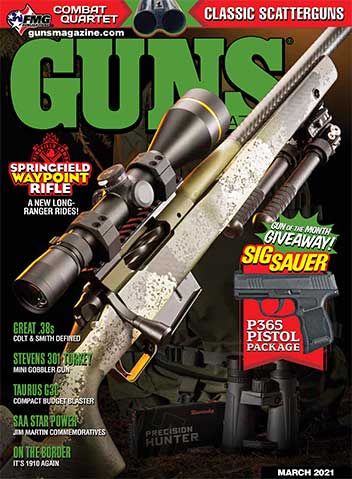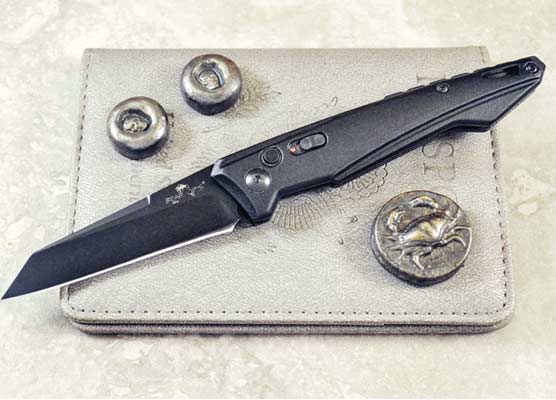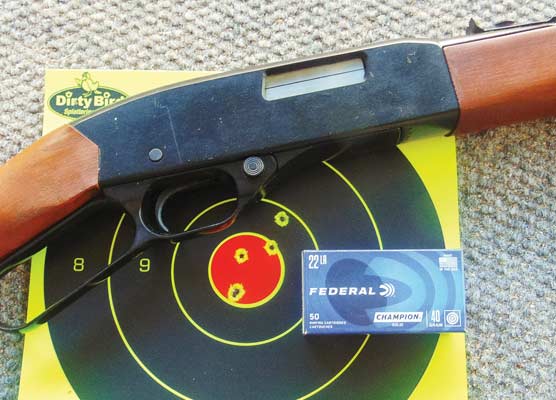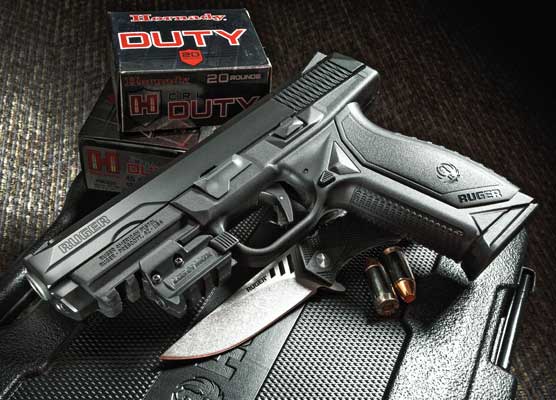The special .44 Special
A classic is still tops
At the dawn of the 20th century America Smith & Wesson introduced the New Century revolver. This beautiful sixgun had other names such as the Model of 1908, the .44 Hand Ejector 1st Model but it is more widely known to both collectors and shooters as the Triple-Lock.
Both Colt and Smith & Wesson had produced double-action sixguns in the 1870s and 1880s, however in the 1890s they started looking forward at what would become the first modern double-action revolvers. For Colt their premier design was the New Service while Smith & Wesson came up with the smaller-frame Military & Police. Both of these revolvers featured swingout cylinders and simultaneous ejection. The S&W Police was first chambered in the .38 Special in 1899 or 1901, according to which expert you choose to believe, and in 1907 they expanded the medium-frame Military & Police to a large frame .44.
Smith & Wesson
The Triple-Lock featured an enclosed ejector rod and the cylinder locked in three places — at the rear, at the front of the ejector rod and with a beautifully machined third locking feature at the front of the cylinder on the frame. Even today this Smith & Wesson is still regarded by many as the finest revolver ever produced. Smith & Wesson already had the superbly accurate .44 Russian and could have easily chambered the new sixgun for this cartridge. However, they chose to lengthen the .44 Russian’s 0.97″ length to 1.16″ and the result was a new cartridge, the .44 Special.
They did not know it at the time but Smith & Wesson was on the brink of perfection. They now had a beautifully crafted sixgun and a new cartridge that could easily be safety loaded to eclipse the .45 Colt. But, as so often happens, instead of making a real change in sixgunning the .44 Special was loaded to the exact same specifications as the .44 Russian using the same round-nosed bullet. Instead of a 250-grain bullet that could easily have been loaded to 900—1,000 fps, the .44 Special stayed at the same 750 fps as the .44 Russian. It was an accurate and easy-shooting load but could have been so much more.
The .44 Special may have started as a sedate sixgun cartridge, but did not stay this way very long. What S&W and ammunition factories did not do, handloaders did. Starting in the 1920s men like Elmer Keith, Gordon Boser, Ray Thompson, John Lachuk and others who were members of the .44 Associates experimented and traded information on the .44 Special. Foremost of these was Elmer Keith who spent 30 years selling the attributes of the heavy-loaded .44 Special.
Using balloon head brass, which had a larger capacity than current solid head brass, Keith started first with #80 powder and then when it arrived, #2400 powder loaded under his #429421, a 250-grain semi-wadcutter bullet. Keith claimed 1,100 fps with #80 and 1,200 fps with the new #2400 powder. I have duplicated his loads using the original style brass, both powders and his bullet and found him to be correct.
The Smith & Wesson Triple-Lock was only produced until 1915, and then to save $2 per gun, they dropped the third locking feature and the enclosed ejector rod and the result was the 2nd Model Hand Ejector. Dedicated sixgunners asked over and over again for Smith & Wesson to bring back the Triple-Lock. In 1926 the 3rd Model Hand Ejector arrived with a return to the enclosed ejector rod, however not the third locking feature.
After World War II the 4th Model or Model of 1950 arrived and this would be used in a few short years as the platform for the .44 Magnum. The 1950 Target Model .44 Special is probably in reality an even better sixgun than the Triple-Lock. These were offered in 6-1/2″ for target shooting and outdoor use and the 4″ version for an easy packing sixgun for self-defense or general everyday carry. A very few 5″ were also offered. The 1950 Target was dropped in the mid-1960s. However, in the early 1980s Smith & Wesson brought it back as the Model 24-3 and also a stainless version, the Model 624. Both of these were offered in standard 6-1/2″ and 4″ versions.
The Horse
Colt chambered their New Service in .44 Special both in standard and Flat-Top Target versions. I have found the latter to be a superbly accurate sixgun. Colt also chambered all three generations of their Single Action Army in .44 Special and the 2nd and 3rd Generation New Frontiers were available in .44 Special. The .44 Special New Frontiers make exceptionally good hunting sixguns. During the 175th Anniversary of Colt in 2011 I acquired one of the 5-1/2″ New Frontier .44 Specials and found it to be an excellent shooting .44. Today, if you want a .44 Colt about the only way to get one is to search gun shops and gun shows for a used example. USFA also offered both Single Action and Flat-Top Target versions in .44 Special before they closed their doors. These were beautifully finished and fitted Specials.
Special Hunter
The .44 Special with heavy loads in the early Smith & Wesson and Colt Revolvers was the first true hunting sixgun cartridge and remains an excellent choice today for deer-sized game at reasonable ranges. I have taken some large feral pigs in the 500- to 650-lb. class with the Keith Heavy .44 Special load. As an everyday working load today, my standard choice is now Skeeter Skelton’s load of a 250-grain semi-wadcutter over 7.5 grains of Unique for right around 950 fps. This will do all I require of a sixgun at this stage of my life. To duplicate the original .44 Special I use the same bullet over 6.0 grains of Unique, 5.5 grains of W231, or 4.5 grains of Red Dot or Tite Group. The more I shoot, the more I enjoy this easy shooting and accurate load.
As a self-defense proposition it would be hard to find a better cartridge than a properly loaded .44 Special. The Keith load is definitely not the best choice nor at the other end of the spectrum, the standard original 246-grain round-nose bullet load which has been the standard for over 100 years. There are a few offerings such as the Speer 200-grain Gold Dot HP offered as a self-defense load.
